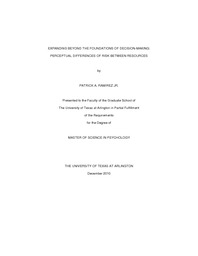
ATTENTION: The works hosted here are being migrated to a new repository that will consolidate resources, improve discoverability, and better show UTA's research impact on the global community. We will update authors as the migration progresses. Please see MavMatrix for more information.
Show simple item record
| dc.contributor.author | Ramirez, Patrick A. | en_US |
| dc.date.accessioned | 2011-03-03T21:52:40Z | |
| dc.date.available | 2011-03-03T21:52:40Z | |
| dc.date.issued | 2011-03-03 | |
| dc.date.submitted | January 2010 | en_US |
| dc.identifier.other | DISS-10943 | en_US |
| dc.identifier.uri | http://hdl.handle.net/10106/5482 | |
| dc.description.abstract | This research examined how resources such as life, food, and money are calculated in decision-making. Presently, the field assumes that various types of resources have the same value when a choice is being made. The study tested the assumption by comparing how individuals responded to two similar sunk cost scenarios (investing in a failing venture) where one task situation dealt with money and the other situation concerned life decisions. There were three hypotheses tested in this experiment. The first hypothesis predicted that participants would make more investments for an ill pet when compared with a failing business, which was confirmed. The second hypothesis predicted that the amount of pleasure experienced with gains and displeasure experienced with losses would be greater for the pet task when compared with the business task, which was also confirmed. The third hypothesis predicted that investing would be better predicted for the pet task than the business task by the participant pleasure ratings. The results followed a trend opposite to that which the third hypothesis had predicted. | en_US |
| dc.description.sponsorship | Levine, Daniel S. | en_US |
| dc.language.iso | en | en_US |
| dc.publisher | Psychology | en_US |
| dc.title | Expanding Beyond The Foundations Of Decision-making: Perceptual Differences Of Risk Between Resources | en_US |
| dc.type | M.S. | en_US |
| dc.contributor.committeeChair | Levine, Daniel S. | en_US |
| dc.degree.department | Psychology | en_US |
| dc.degree.discipline | Psychology | en_US |
| dc.degree.grantor | University of Texas at Arlington | en_US |
| dc.degree.level | masters | en_US |
| dc.degree.name | M.S. | en_US |
Files in this item
- Name:
- Ramirez_uta_2502M_10943.pdf
- Size:
- 1.696Mb
- Format:
- PDF
This item appears in the following Collection(s)
Show simple item record


